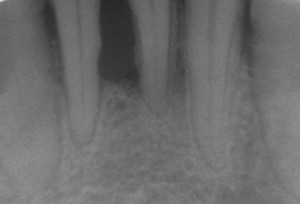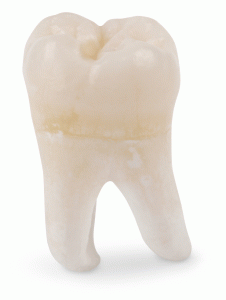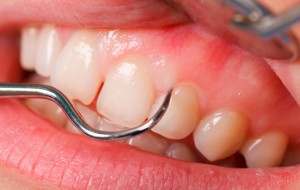 Periodontal disease – another term for “gum disease” – is not one single disease, but a disorder that can result in an escalating set of problems. Many adults suffer a periodontal issue at some point in their lives, triggered by everything from neglect in brushing and flossing to hormonal changes women, smoking, diabetes, medications and even genetics.
Periodontal disease – another term for “gum disease” – is not one single disease, but a disorder that can result in an escalating set of problems. Many adults suffer a periodontal issue at some point in their lives, triggered by everything from neglect in brushing and flossing to hormonal changes women, smoking, diabetes, medications and even genetics.
The root cause of gum disease lies in the bacteria that populates our mouths. Careful brushing and flossing can control some bacteria, but if the maintenance is not consistent or done incorrectly, the bacteria forms sticky plaque.
If left untreated, the plaque becomes a foundation for a set of increasingly difficult conditions:
 Tartar.
Tartar.
As an outcome of plaque, hardened tartar covers the tooth enamel and forms a protective shield for bacteria. You’re likely familiar with plaque and tartar from your teeth-cleaning trips to the dentist – the dental hygienist scrapes the stubborn coating off areas of the teeth (often the insides or hard-to-reach back teeth that don’t get enough proper attention) before the dentist does his examination.
 Gingivitis.
Gingivitis.
The tartar buildup on teeth transmits bacteria into the gum line, and that bacteria could lead to gingivitis. This condition is characterized by soreness, redness and swelling in the gums, making eating more difficult. By the time you feel the symptoms of gingivitis the bacteria has already taken hold, so it’s important to book an appointment with your dentist, even if it’s before your regularly scheduled checkup.

This radiograph shows significant bone loss between the two roots of a tooth (black region). The spongy bone has receded due to infection under tooth, reducing the bony support for the tooth. Source: Wikipedia
Periodontitis.
As uncomfortable as tartar buildup and gingivitis are, these two conditions are generally treatable with immediate results. However, left untreated, these disorders could next lead to periodontitis, the most serious of the gum diseases. This infection damages the soft tissue and bone structure supporting the teeth. The end result of periodontitis include tooth loss and permanent destruction to the bone structure. The symptoms of this periodontal disease are severe ones: purple-ish cast to the gums, bleeding from the gums, loose teeth and a metallic taste in the mouth. Other risks include the infection spreading to the rest of the body.
Prevention of periodontal disease
Good daily oral hygiene can prevent periodontal disease:
- Brushing properly on a regular basis (at least twice daily)
- Flossing daily
- Using an antiseptic mouthwash
- Regular dental check-ups and professional teeth cleaning
Treatment of periodontal disease
The good news is that early-stage periodontal issues are treatable. A thorough cleaning, which includes a deep-cleaning method called scaling, can eliminate existing plaque and tartar, though it’s up to you to maintain that advantage through regular, and correct, brushing and flossing.
Once you have gingivitis, your dentist may combine a deep cleaning with a course of antibacterial or antiseptic oral treatments to reduce the symptoms and attack the bacteria at its foundation.
Periodontitis may require more extensive treatment; advanced cases are sometimes addressed with in-patient surgical procedures like flap surgery and soft tissue grafts. A skilled dentist specializing in cosmetic procedures can help bring your teeth and gums back to their normal look and function.

 Tartar.
Tartar. Gingivitis.
Gingivitis.